A Green Party for Your Pets?
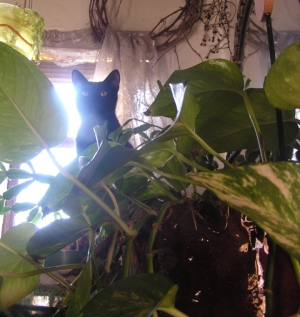
What happened to that nice spider plant I used to have? Oops—while enjoying the scene out the window, Cookie forgot it wasn’t just a clump of grass and chewed it down to little nubbins. Then, because it really wasn’t grass and really wasn’t digestible by her little system, she deposited it back on your carpet in a most inelegant manner.
And that wandering jew? Lucy used it for a bed? I’ll bet she looked sweet.
Oh, and that special dozen roses you got at Valentine’s Day with all the greens and baby’s breath? Did Kelly think it was for her?
This article covers information and resources for both cats and dogs, and since I live with cats all the references and photos are of my own cats. Cats and dogs have different reactions to many plants and other substances, but many toxic dangers exist for both of them.
You can’t really punish them for following both a natural impulse and a physical need. Cats chew on grasses specifically to help cleanse their mouth and digestive system, and to add fiber to their primarily protein diet to aid in elimination. And, of course, an indoor kitty will take what she can get to simulate the natural outdoor environment she craves, digging in the soil of a potted plant or making a bed of a lush, healthy pot of foliage.

Cats aren’t necessarily particular in what they’ll nibble on; generally they’ll try anything green, and some cats will completely chew down a plant that can’t have tasted very good and wasn’t very easy to chew.
While it may be amusing if you’re not too attached to your plants, it can be EXTREMELY DANGEROUS to your cat. Several common houseplants, or plants we bring in for some holidays or for winter, are deadly, and another longer list can cause a range of symptoms from temporary discomfort to permanent health problems.
And while many people know about the dangers of houseplants, plants are just as toxic in a pretty arrangement from the florist as well as when they are growing in the yard. My cats find anything green to be a tasty snack!
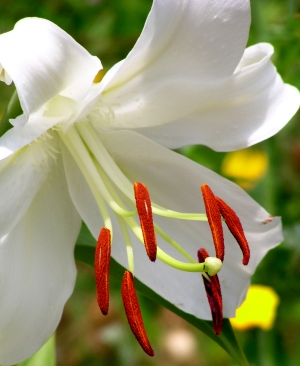
For instance, consider the lilies we bring into our home around Easter, or other species in the lily family (including those we may have as cut flowers). According to Jill A. Richardson, DVM, Veterinary Poison Information Specialist, ASPCA/National Animal Poison Control Center, “Several types of lilies can be deadly to cats. Easter lily, tiger lily, rubrum, Japanese show lily, some species of day lily, and certain other members of the Liliaceae family can cause kidney failure in cats. Within only a few hours of ingestion of the plant material, the cat may vomit, become lethargic, or develop a lack of appetite. These signs continue and worsen as kidney damage progresses. Without prompt and proper treatment by a veterinarian, the cat will develop kidney failure in approximately 36-72 hours. All parts of these lilies are considered toxic to cats and consuming even small amounts can cause severe poisoning.”(1)
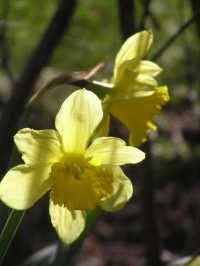
While most plants are not that immediately toxic, other plants, such as azalea, lily of the valley, yew and bulbs we might force to bloom, including tulip, daffodil and crocus, can be deadly to cats in impaired health or kittens, since they’re small enough to get a big dose with an enthusiastic bite. Though not deadly for adult cats in good health, they’ll often cause extreme abdominal pain, nausea, salivation and vomiting. Repeated exposure can be cumulative with some plants.
That was not intended to scare you, but to illustrate the seriousness of the cat and plant issue. The problem is that, while you may get some cats to stay away from your plants, most cats will return again and again, even if they suffer discomfort from their snack. The best way to keep your cats safe from plants is to put the plants completely out of reach-bearing in mind that cats can jump six times their height and can be ingenious about launching from strategic furniture to get into a hanging basket. Sometimes it is necessary to completely remove the plant from the house, no matter how much you like it. This has been my solution, much as I need to have my greenery in the house.
Signs of plant poisoning may include vomiting, diarrhea, and swelling or pain inside the cat’s mouth. If you know or suspect which plant you cat has eaten, identify the plant by name when you call your veterinarian. Bring samples of the plant’s leaves or flowers when you take your cat to the veterinarian for treatment.

As for the non-toxic plants, even though Mewsette won’t suffer if she chews on them (unless you get your hands on her), you still don’t want her shredding your greenery. Several commercial sprays will give the plant a bad smell and/or taste without damaging the plant with recommended use, and a nibble by Mewsette will not harm her. One product is “Bitter Apple for Plants”, a stronger version of which is available for dogs learning not to chew on everything. Other products are named “Off for Cats” and such like, and simply smell bad.
You can also try your own home brew by dabbing hot sauce on the tips of some of the leaves, or rubbing a citrus peel on the leaf. For the sake of your plants, however, just try it on one or two leaves to make sure you won’t fry the whole plant in an effort to keep Mimi from eating it.
You could also place “Sticky Paws” on the countertop around the plant so that when she stepped close to the plant she would step on the product and back off; please read the instructions on the Sticky Paws package for what surfaces are appropriate for its use.
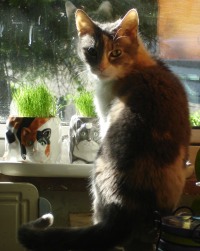
One other thing to help the situation—and it’s a nice thing to do for your cat even if you don’t have a plant problem—is to plant her own pot of greens and make it available to her at all times. Don’t use regular plant seeds such as grass seed because some seeds are treated and they don’t all grow well inside; instead, purchase “cat greens”, usually a mixture of wheat, oats and barley grains, all three of which are not only a pleasure for your cat, but full of nutrition. Some other commercial “cat greens” mixtures contain catnip, a sure winner, sage, parsley, chickweed, colt’s foot grass, and other herbs and wild plants that your cat would eat if left outdoors. Alternately, get grass seed you’re sure hasn’t been treated.
Most of these plants can be grown in a small container on a windowsill, and if you keep two containers growing, one available to the cat and one just sprouting, you can have a constant treat for her. These plants need a good bit of sunlight to thrive, so try to find a sunny spot that your cat can get to. It will serve two purposes: because she tends to chew when she’s gazing at the outdoors, you’ve provided exactly what she needs for her little interlude.
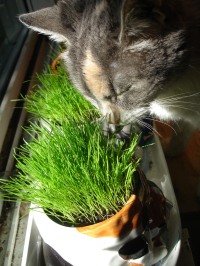
Many local shelters and websites have information on growing grass and other plants indoors for your cats to enjoy, and many pet supply stores actually sell pre-planted organic seeds that you only have to water and place in a sunny location. If you plant the seeds yourself, it’s important to make sure you use potting soil that has no commercial fertilizers in it since, if your animals are like my cats, they’ll eat it right down to the roots and even eat some soil! Also, the soil may be spilled if the plant is knocked over. To be completely safe, you can always use just plain old peat moss, which doesn’t contain enough nutrition to sustain a large plant, but will grow grass and small herb plants just fine.
And am amazing resource in finding indoor and outdoor plants that are toxic to dogs, cats and horses is on the ASPCA website at http://www.aspca.org/pet-care/poison-control/ under both “17 Common Poisonous Plants” and a hugely comprehensive list of over 400 plant species in “Toxic and Non-toxic Plants”, which even has photos.
Also, in my series on creating your Backyard Wildlife Habitat, I address the issue of choosing pet-safe plants for your backyard in Bringing it All Together, Enhancing and Developing Your Habitat.
Shelters and animal welfare organizations also have comprehensive lists of plants toxic to cats and potentially toxic foods, visit the Humane Society of the United States for Keep Your Pets Safe and Happy During the Holiday Season and the ASPCA’s Holiday Safety Tips. Both have tips and links to information on toxic plants and “pet-safe floral arrangements”, and various potentially toxic foods. Also keep a link the the ASPCA’s Animal Poison Control Center for reference at before your purchase a house plant or bring an arrangement into the house.
This article was authored by me and first published in Cat Chat on the My Three Cats website. Visit to read other articles I’ve written for them over the years!
(1) Information obtained from http://www.cfainc.org/articles/lily-dangers.html


Pingback: The Creative Cat - Living Green With Pets: Bringing Plants Indoors
Marg~I’m working on organizing and posting all the stories on my main website. I’ve maintained that website for about 13 years and it’s all a mish-mash of different coding and styles and all and most of them are there already–somewhere. I’ll post links as I get them together.
As for the backyard–I have bulbs all over the place, but mostly the cats chew on the grass and leave the daffodils and tulips alone. And good thing you didn’t use the flea stuff, whatever it was! I don’t use anything out there but fleas were never a problem because the “habitat” is in balance, but with our recent mild winters the ones I’ve taken outside with me got fleas and brought them inside. I’ve used Frontline and just done my best to keep the house swept and washed, but I’m hoping this recent winter will ahve killed off a lot of things I’d rather weren’t living in my garden…
PS We want to hear the story of Sophie.
Thanks for all that great information. I knew about most of it but didn’t know about the lily until last year so I quit buying Easter lilies. The only problem is that I do have some out in my yard but there are so many other things outside for them to eat, hopefully they will stay away from the lilies. And I think I will get some of that Bitter Apple or some cat off. Have to go see where to get it. Hopefully my guys and gals will just chew on the grass outside. A friend of mine tried to get me to spread that stuff around the yard that kills fleas but after I read the directions, I sure didn’t do it. It would have killed the cat.
Have a great week end.